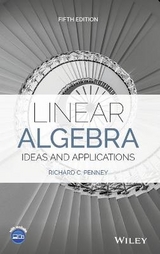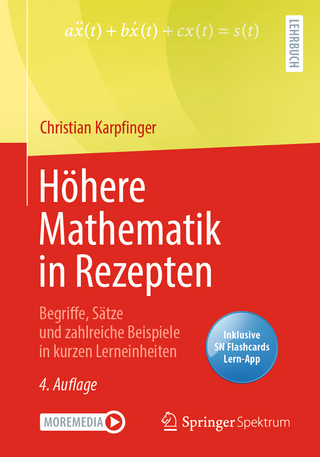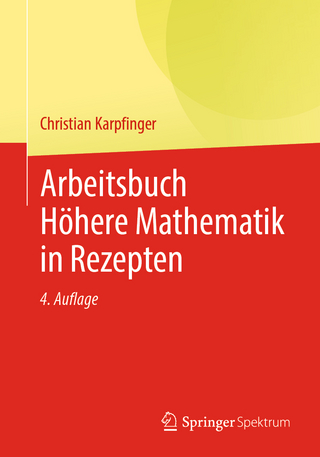
Linear Algebra
John Wiley & Sons Inc (Verlag)
978-1-118-90958-4 (ISBN)
- Titel erscheint in neuer Auflage
- Artikel merken
Praise for the Third Edition This volume is ground-breaking in terms of mathematical texts in that it does not teach from a detached perspective, but instead, looks to show students that competent mathematicians bring an intuitive understanding to the subject rather than just a master of applications. Electric Review A comprehensive introduction, Linear Algebra: Ideas and Applications, Fourth Edition provides a discussion of the theory and applications of linear algebra that blends abstract and computational concepts. With a focus on the development of mathematical intuition, the book emphasizes the need to understand both the applications of a particular technique and the mathematical ideas underlying the technique. The book introduces each new concept in the context of an explicit numerical example, which allows the abstract concepts to grow organically out of the necessity to solve specific problems. The intuitive discussions are consistently followed by rigorous statements of results and proofs.
Linear Algebra: Ideas and Applications, Fourth Edition also features: * Two new and independent sections on the rapidly developing subject of wavelets * A thoroughly updated section on electrical circuit theory * Illuminating applications of linear algebra with self-study questions for additional study * End-of-chapter summaries and sections with true-false questions to aid readers with further comprehension of the presented material * Numerous computer exercises throughout using MATLAB(R) code Linear Algebra: Ideas and Applications, Fourth Edition is an excellent undergraduate-level textbook for one or two semester courses for students majoring in mathematics, science, computer science, and engineering. With an emphasis on intuition development, the book is also an ideal self-study reference.
Richard C. Penney, PhD, is Professor in the Department of Mathematics and Director of the Mathematics/Statistics Actuarial Science Program at Purdue University. He has authored numerous journal articles, received several major teaching awards, and is an active researcher.
PREFACE XI FEATURES OF THE TEXT XIII ACKNOWLEDGMENTS XVII ABOUT THE COMPANION WEBSITE XIX 1 SYSTEMS OF LINEAR EQUATIONS 1 1.1 The Vector Space of m x n Matrices 1 The Space Rn 4 Linear Combinations and Linear Dependence 6 What is a Vector Space? 11 Exercises 17 1.1.1 Computer Projects 22 1.1.2 Applications to Graph Theory I 25 Exercises 27 1.2 Systems 28 Rank: The Maximum Number of Linearly Independent Equations 35 Exercises 38 1.2.1 Computer Projects 41 1.2.2 Applications to Circuit Theory 41 Exercises 46 1.3 Gaussian Elimination 47 Spanning in Polynomial Spaces 58 Computational Issues: Pivoting 61 Exercises 63 Computational Issues: Counting Flops 68 1.3.1 Computer Projects 69 1.3.2 Applications to Traffic Flow 72 1.4 Column Space and Nullspace 74 Subspaces 77 Exercises 86 1.4.1 Computer Projects 94 Chapter Summary 95 2 LINEAR INDEPENDENCE AND DIMENSION 97 2.1 The Test for Linear Independence 97 Bases for the Column Space 104 Testing Functions for Independence 106 Exercises 108 2.1.1 Computer Projects 113 2.2 Dimension 114 Exercises 123 2.2.1 Computer Projects 127 2.2.2 Applications to Differential Equations 128 Exercises 131 2.3 Row Space and the rank-nullity theorem 132 Bases for the Row Space 134 Computational Issues: Computing Rank 142 Exercises 143 2.3.1 Computer Projects 146 Chapter Summary 147 3 LINEAR TRANSFORMATIONS 149 3.1 The Linearity Properties 149 Exercises 157 3.1.1 Computer Projects 162 3.2 Matrix Multiplication (Composition) 164 Partitioned Matrices 171 Computational Issues: Parallel Computing 172 Exercises 173 3.2.1 Computer Projects 178 3.2.2 Applications to Graph Theory II 180 Exercises 181 3.3 Inverses 182 Computational Issues: Reduction versus Inverses 188 Exercises 190 3.3.1 Computer Projects 195 3.3.2 Applications to Economics 197 Exercises 202 3.4 The LU Factorization 203 Exercises 212 3.4.1 Computer Projects 214 3.5 The Matrix of a Linear Transformation 215 Coordinates 215 Isomorphism 228 Invertible Linear Transformations 229 Exercises 230 3.5.1 Computer Projects 235 Chapter Summary 236 4 DETERMINANTS 238 4.1 Definition of the Determinant 238 4.1.1 The Rest of the Proofs 246 Exercises 249 4.1.2 Computer Projects 251 4.2 Reduction and Determinants 252 Uniqueness of the Determinant 256 Exercises 258 4.2.1 Volume 261 Exercises 263 4.3 A Formula for Inverses 264 Exercises 268 Chapter Summary 269 5 EIGENVECTORS AND EIGENVALUES 271 5.1 Eigenvectors 271 Exercises 279 5.1.1 Computer Projects 282 5.1.2 Application to Markov Processes 283 Exercises 285 5.2 Diagonalization 287 Powers of Matrices 288 Exercises 290 5.2.1 Computer Projects 292 5.2.2 Application to Systems of Differential Equations 293 Exercises 295 5.3 Complex Eigenvectors 296 Complex Vector Spaces 303 Exercises 304 5.3.1 Computer Projects 305 Chapter Summary 306 6 ORTHOGONALITY 308 6.1 The Scalar Product in RN 308 Orthogonal/Orthonormal Bases and Coordinates 312 Exercises 316 6.2 Projections: The Gram-Schmidt Process 318 The QR Decomposition 325 Uniqueness of the QR Factorization 327 Exercises 328 6.2.1 Computer Projects 331 6.3 Fourier Series: Scalar Product Spaces 333 Exercises 341 6.3.1 Application to Data Compression: Wavelets 344 Exercises 352 6.3.2 Computer Projects 353 6.4 Orthogonal Matrices 355 Householder Matrices 361 Exercises 364 Discrete Wavelet Transform 367 6.4.1 Computer Projects 369 6.5 Least Squares 370 Exercises 377 6.5.1 Computer Projects 380 6.6 Quadratic Forms: Orthogonal Diagonalization 381 The Spectral Theorem 385 The Principal Axis Theorem 386 Exercises 392 6.6.1 Computer Projects 395 6.7 The Singular Value Decomposition (SVD) 396 Application of the SVD to Least-Squares Problems 402 Exercises 404 Computing the SVD Using Householder Matrices 406 Diagonalizing Matrices Using Householder Matrices 408 6.8 Hermitian Symmetric and Unitary Matrices 410 Exercises 417 Chapter Summary 419 7 GENERALIZED EIGENVECTORS 421 7.1 Generalized Eigenvectors 421 Exercises 429 7.2 Chain Bases 431 Jordan Form 438 Exercises 443 The Cayley-Hamilton Theorem 445 Chapter Summary 445 8 NUMERICAL TECHNIQUES 446 8.1 Condition Number 446 Norms 446 Condition Number 448 Least Squares 451 Exercises 451 8.2 Computing Eigenvalues 452 Iteration 453 The QR Method 457 Exercises 462 Chapter Summary 464 ANSWERS AND HINTS 465 INDEX 487
| Erscheint lt. Verlag | 5.1.2016 |
|---|---|
| Verlagsort | New York |
| Sprache | englisch |
| Maße | 165 x 235 mm |
| Gewicht | 902 g |
| Themenwelt | Mathematik / Informatik ► Mathematik ► Algebra |
| Mathematik / Informatik ► Mathematik ► Angewandte Mathematik | |
| ISBN-10 | 1-118-90958-5 / 1118909585 |
| ISBN-13 | 978-1-118-90958-4 / 9781118909584 |
| Zustand | Neuware |
| Informationen gemäß Produktsicherheitsverordnung (GPSR) | |
| Haben Sie eine Frage zum Produkt? |
aus dem Bereich



